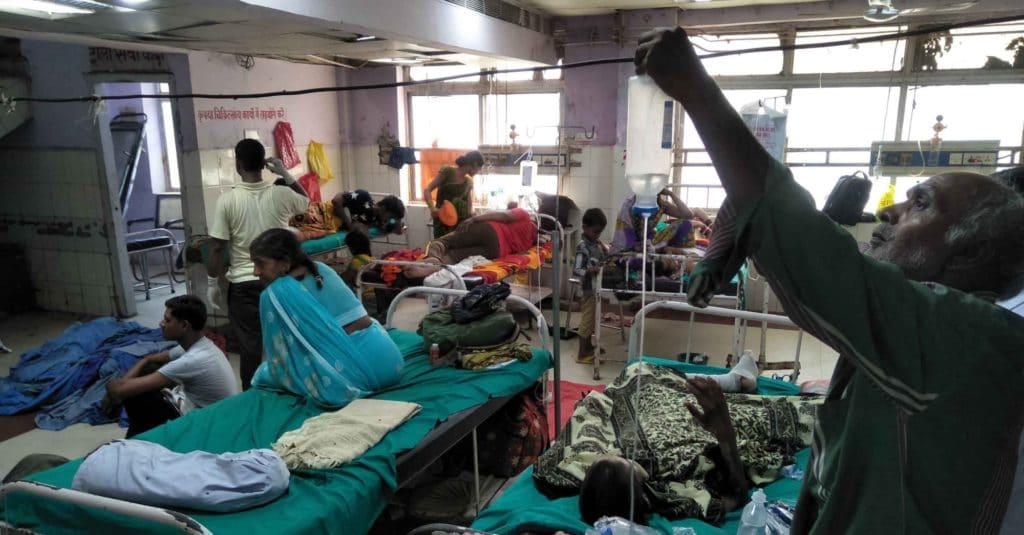India, the seventh largest country in the world with 1/5th of its population, is headed towards major healthcare problems, according to a national-level state-wise disease burden study of the country. While the disease burden rate in India has improved since 1990, it was 72 per cent higher per person than that in Sri Lanka or China in 2016, the report titled “India: Health of the Nation’s States” said.
The main reasons for disease burden are non-communicable diseases, child and maternal malnutrition, tuberculosis, diarrhoeal diseases and respiratory infections. In 2016, 55 per cent people died due to non-communicable diseases, and 12 per cent due to injuries while infectious and associated diseases were less than half in all states in 2016, the study conducted by the Indian Council of Medical Research, Gates Foundation funded-Public Health Foundation of India and Institute for Health Metrics and Evaluation, showed. The survey published by the Indian Health Ministry was released by Vice President M Venkaiah Naidu last week, and coincided with the India visit of Microsoft co-founder Bill Gates, and his wife Melinda.
“The total spending on public health is too low,” Gates told the Times of India. “Every other country that moved to middle income status spends over 3 per cent (of its GDP) on public health. If you’re out of pocket (paying for healthcare) it can bankrupt your family. Most countries that moved to middle income status, provide insurance – either through the private sector or through government or some weird mix.” India currently spends a little more than 1 per cent of the GDP on healthcare.
“The biggest disappointment I have about India — though I am not an education funder — is the state of the education system here. It should be far better than it is today,” Gates added.
The study provides a map for the country’s disease burden as measured by financial cost, mortality, morbidity, or other indicators.
While the study showed life expectancy to have gone up from 59.7 years in 1990 to 70.3 years in 2016 for females, and that infectious diseases led to less deaths every year, it indicated that there is a significant rise in deaths due to non-communicable diseases. States like Bihar and UP are still burdened with children succumbing to diarrhoea. On the other hand, Tamil Nadu, Kerala, Punjab and Goa have been shown to have become centers of non-communicable diseases (NCDs) like cancer and lifestyle-related ailments like heart diseases and diabetes.
While the disease burden due to child and maternal malnutrition has dropped in India substantially since 1990, this is still the single largest risk factor, responsible for 15 per cent of the total disease burden in India in 2016, the report said.
The healthcare survey presents an alarming situation for India to act upon. The country had been working persistently on reducing child mortality since becoming a signee to the Millennium Development Goals. And providing healthy lives to people of all ages continues to be one of the Sustainable Development Goals for countries all over the world. However, India’s rising air and water pollution is leading to more respiratory issues and infections.
“The big number we look at is under-five mortality, which has gone down dramatically but it’s still far too high. Six million kids die before the age of five, 5 per cent of all kids die before the age of five. Before we got started it was 10 per cent, now it’s 5 per cent. By 2030 our goal is it should be 2.5 per cent and to get from 5 per cent to 2.5 per cent you’ve got to handle malaria, diarrhoea, and pneumonia,” Gates said.
India will have to be persistent towards improving public health and spending a larger part of the GDP for the health of the people, and use of technology is going to be a large part of it.
“We have always known that another cause of underfive mortality is because kids are freezing to death. So you do kangaroo care, you hold them, (share your body warmth with the child, like a kid in a mother kangaroo’s pouch). People are not going to hold them 24 hours, so making a one-dollar sensor that would flash or make your cellphone beep if the child is getting too cold could be a solution. There’s a lot to be figured out to get to that 2.5 per cent and then get to half of that,” Gates added.
